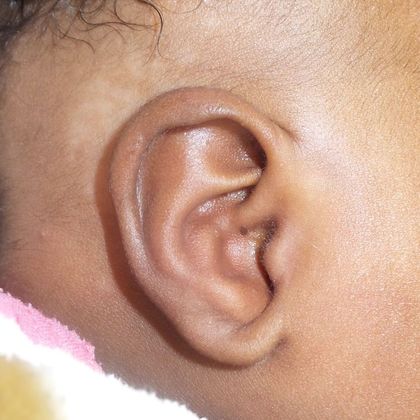The inverted conchal bowl deformity is a rare ear condition that causes the conchal area to protrude. The conchal area of the ear is ordinarily concave, facing toward the head. However, this deformity causes the conchal area to face outward and away from the head. Inverted conchal bowl deformity poses cosmetic and functional concerns for infants.
The deformed area of an inverted conchal bowl deformity can cause problems with hearing and cleaning of the ears by blocking the inner ear canal. Although its causes are unknown, it can be treated non-surgically and surgically.
Non-Surgical Correction in Babies with Inverted Conchal Bowl Deformity
Newborns with inverted conchal bowl deformity can experience problems with hearing and hygiene early on in life without treatment. Experts worldwide depend on ear molding procedures to achieve painless and effective reversal of ear deformities in infants. The process uses a silicone prosthesis affixed to the conchal bowl area, gently pushing on the deformed cartilage, and reshaping the concha to a healthy shape in as little as four weeks.
Many parents prefer to use ear molding to correct ear deformities in infants due to its non-surgical nature. Ear molding has a high level of success due to the following factors involved in its application:
- Responsive: The high estrogen levels in the womb persist for the first six to eight weeks of your newborn’s life. During this time, the cartilage within the ears remains malleable and easy to reshape. As these levels drop, the ears will become increasingly rigid.
- Painless: Due to the flexibility of the ears during this time, the molding process is painless, as gentle pressure is applied.
- Effective: Each treatment period is at least four weeks in length. When this proves insufficient, an additional treatment period can be added. Best results are obtained when starting in the first few weeks after birth.
- Non-Surgical: No one wants to perform surgery on a newborn when non-surgical options exist. Ear shaping comes with no risk of infection, no scarring, and no uncomfortable healing period.
These factors continue to make ear molding the preferred approach for treating ear deformities in infants.
Ear Molding for Newborns with Inverted Conchal Bowl Deformity
If you have a newborn with inverted conchal bowl deformities, then non-surgical ear molding can give them back healthy and normal appearing ears without surgery. Dr. Jandali offers non-surgical ear molding treatment for newborn conchal bowl deformities at his practice in Connecticut. During your infant’s visits, Dr. Jandali will mold and monitor their progress to ensure they receive healthy, naturally shaped ears. For more information, contact Dr. Jandali’s office today to discuss your baby’s treatment options.
Inverted Conchal Bowl Gallery


